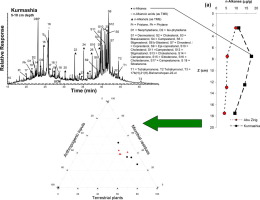当前位置:
X-MOL 学术
›
J. Hydrol.
›
论文详情
Our official English website, www.x-mol.net, welcomes your
feedback! (Note: you will need to create a separate account there.)
Impacts of Mesopotamian wetland re-flooding on the lipid biomarker distributions in sediments
Journal of Hydrology ( IF 5.9 ) Pub Date : 2018-03-01 , DOI: 10.1016/j.jhydrol.2018.01.030 Ahmed I. Rushdi , Ali A.Z. DouAbul , Sama S. Al-Maarofi , Bernd R.T. Simoneit
Journal of Hydrology ( IF 5.9 ) Pub Date : 2018-03-01 , DOI: 10.1016/j.jhydrol.2018.01.030 Ahmed I. Rushdi , Ali A.Z. DouAbul , Sama S. Al-Maarofi , Bernd R.T. Simoneit

|
Abstract Shallow sediment core samples from two locales in the Mesopotamian marshlands of Iraq were analyzed to characterize the extractable organic (lipid) compounds, and their sources and distributions after hydrological restoration by re-flooding of the marshes. Dried samples were extracted with a dichloromethane/methanol mixture before analysis by gas chromatography-mass spectrometry (GC–MS). The major compounds were n -alkanes, fatty acids and alcohols, steroids, terpenoids, hopanes, steranes, unresolved complex mixture (UCM), and plasticizers. The lipid compounds in Kurmashia (Al-Hammar marshes) were generally higher in concentration than in Abu Zirig (Central marshes), and decreased with core depths for both sites. This concentration decrease with core depth is attributed to transformation, biodegradation and variable input processes. The distribution patterns of the lipids in the sediment cores indicated that the Abu Zirig area was drier than Kurmashia before the re-flooding process. Furthermore, the concentration of the compounds in the surface sediment the Abu Zirig core was as high and similar to that in Kurmashia, reflecting the re-flooding impacts on the marsh and the revival of the wetland. The major sources of these lipids were from natural terrestrial vegetation (35–66% for Abu Zirig; 40–49% for Kurmashia), microbial (plankton) residues and bacteria (27–52% for Abu Zirig; 39–43% for Kurmashia), with a minor contribution from anthropogenic sources including plastic wastes and petroleum (6–13% for Abu Zirig; 9–18% for Kurmashia).
中文翻译:

美索不达米亚湿地再洪水对沉积物中脂质生物标志物分布的影响
摘要 对伊拉克美索不达米亚沼泽地两个地点的浅层沉积物岩心样品进行了分析,以表征可提取的有机(脂质)化合物及其来源和分布,这些化合物在通过重新淹没沼泽地进行水文恢复后进行。在通过气相色谱-质谱 (GC-MS) 分析之前,干燥的样品用二氯甲烷/甲醇混合物萃取。主要化合物是正烷烃、脂肪酸和醇、类固醇、萜类化合物、藿烷、甾烷、未解析的复合混合物 (UCM) 和增塑剂。Kurmashia(Al-Hammar 沼泽)的脂质化合物浓度通常高于 Abu Zirig(中央沼泽),并且随着两个地点的岩心深度而降低。这种随岩心深度而降低的浓度归因于转化、生物降解和可变输入过程。沉积物岩心中脂质的分布模式表明,在重新淹没过程之前,Abu Zirig 地区比 Kurmashia 地区更干燥。此外,Abu Zirig 核心表层沉积物中化合物的浓度与 Kurmashia 相似,反映了再洪水对沼泽的影响和湿地的复兴。这些脂质的主要来源是天然陆地植被(Abu Zirig 35–66%;Kurmashia 40–49%)、微生物(浮游生物)残留物和细菌(Abu Zirig 27–52%;Kurmashia 39–43% ),包括塑料废物和石油在内的人为来源的贡献很小(Abu Zirig 为 6-13%;Kurmashia 为 9-18%)。
更新日期:2018-03-01
中文翻译:

美索不达米亚湿地再洪水对沉积物中脂质生物标志物分布的影响
摘要 对伊拉克美索不达米亚沼泽地两个地点的浅层沉积物岩心样品进行了分析,以表征可提取的有机(脂质)化合物及其来源和分布,这些化合物在通过重新淹没沼泽地进行水文恢复后进行。在通过气相色谱-质谱 (GC-MS) 分析之前,干燥的样品用二氯甲烷/甲醇混合物萃取。主要化合物是正烷烃、脂肪酸和醇、类固醇、萜类化合物、藿烷、甾烷、未解析的复合混合物 (UCM) 和增塑剂。Kurmashia(Al-Hammar 沼泽)的脂质化合物浓度通常高于 Abu Zirig(中央沼泽),并且随着两个地点的岩心深度而降低。这种随岩心深度而降低的浓度归因于转化、生物降解和可变输入过程。沉积物岩心中脂质的分布模式表明,在重新淹没过程之前,Abu Zirig 地区比 Kurmashia 地区更干燥。此外,Abu Zirig 核心表层沉积物中化合物的浓度与 Kurmashia 相似,反映了再洪水对沼泽的影响和湿地的复兴。这些脂质的主要来源是天然陆地植被(Abu Zirig 35–66%;Kurmashia 40–49%)、微生物(浮游生物)残留物和细菌(Abu Zirig 27–52%;Kurmashia 39–43% ),包括塑料废物和石油在内的人为来源的贡献很小(Abu Zirig 为 6-13%;Kurmashia 为 9-18%)。











































 京公网安备 11010802027423号
京公网安备 11010802027423号